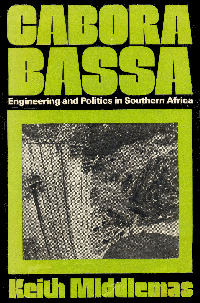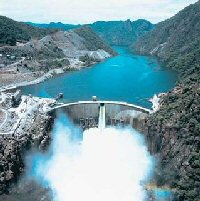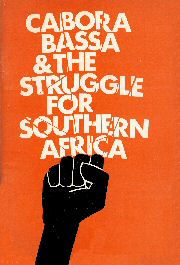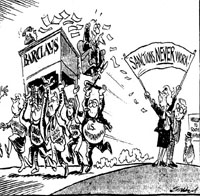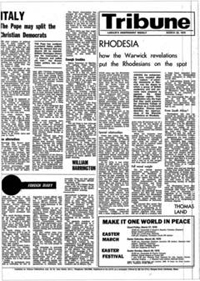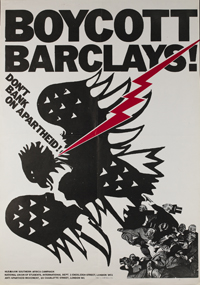Cahora Bassa, 1969-1995
Dossier no. MZ-0116
Page One: The Colonial Period, 1969-1975
«Cabora Bassa is a crime. It is a crime, not only against the Mozambican people, but also against the entire people of southern Africa and of Africa as a whole». S. M. Khan, FRELIMO representative, in a statement to a UN committee, 26 October 1970.
As used here, the term «Cahora Bassa» refers to the dam and the hydroelectric project, as well as the associated and complex trilateral politics and diplomacy involving Mozambique, South Africa and Portugal through the 1970s, 1980s and 1990s. Press coverage of these different aspects of the project has always been extensive.
This dossier makes no claim to present an exhaustive or even particularly coherent selection of available contemporary press coverage. But because of the quantity of materials, the dossier is organised into several webpages, organised around an explicit periodisation that users are free to accept or reject as they wish.
Construction of the dam began in 1969 on a narrow gorge on the Zambezi river in Tete Province. Almost forty years later, in November 2007, Mozambique and Portugal resolved their differences over project debt, and the Mozambican state finally assumed control of Cahora Bassa. The decades of ‘disagreement’ had ranged from guerrilla attacks on the construction site by Frelimo during the independence struggle, to a succession of more or less unsuccessful ‘acordos’ in the 1980s, while the South-African backed Renamo insurgents repeatedly sabotaged pylons carrying power from the dam southwards.
A campaign in the United Kingdom to boycott Barclays Bank, which helped to finance the project, was launched in 1970 and ended in 1986, when Barclays withdrew from the South African market. A cartoon, a poster and a couple of newspaper front pages in the column to the left illustrate this campaign.
Coverage in this dossier ends in 1995, just after the adoption of multipartidarismo in Mozambique. The story of Cahora Bassa, however, continues to the present day.
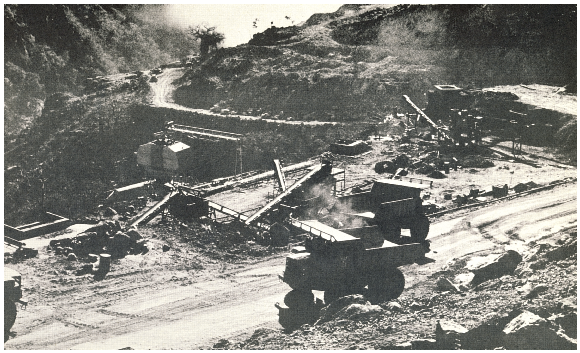
Above: construction work during the early stages of the building of the Cahora Bassa dam in Tete province. The only access to the site was along a purpose-built track via a series of hairpin turns. Photo: World Council of Churches. Left top: the cover of the Keith Middlemas book. Left centre: an aerial view of the completed dam. Left bottom: the cover of a pamphlet published in 1971 by the Programme to Combat Racism of the World Council of Churches.
This first page includes some pieces from what used to be called the capitalist press about the investment involved, as well as reports of attacks by Frelimo fighters against the construction site. This page ends with the independence of Mozambique in 1975.
Links to External Sources
There is a rich variety of resources on Cahora Bassa, both texts and images, available on the World Wide Web, as pretty much any Google query will confirm. The links that follow are merely indicative; the presence or absence of a link to a particular resource does not imply either endorsement by MHN or the opposite.
For Mozambican academic dissertations on Cahora Bassa, mainly at licenciatura level, search the Saber website, here.
The website of Hidroeléctrica de Cahora Bassa [HCB] has a Galeria de Fotos, which includes a selection of pictures of historical interest showing the construction site, the albufeira and so on.
The Aluka and JSTOR websites both have important resources on the Cahora Bassa project, and are worth searching or browsing. These are not public websites, and may require subscriptions in some parts of the world. Aluka includes some of the extensive activist literature from the colonial period and JSTOR offers access to some of the academic work that has been done in English. See, inter alia:
◊ Wolf Radmann.
‘The Zambezi Development Scheme: Cabora Bassa,’ Issue: A Journal of Opinion vol.4 no.2 (Summer 1974), p.47-54 [available from JSTOR here].
◊ Keith Middlemas.
Cabora Bassa: engineering and politics in Southern Africa (London: Weidenfeld and Nicolson, 1975) [available from Aluka here].
◊ Allen Isaacman and Chris Sneddon.
‘Toward a social and environmental history of the building of Cahora Bassa Dam,’ Journal of Southern African Studies vol.26 no.4 (December 2000), p.597-632 [available here].
◊ Allen Isaacman.
‘Displaced People, displaced energy, and displaced memories: the case of Cahora Bassa, 1970-2004,’ International Journal of African Historical Studies vol.38 no. 2 (2005), p.201-238 [available here].
Note that the following article, in French and outdated, is nevertheless publicly available:
◊ Claire Ollivier.
‘Le colosse paralysé,’ Politique Africaine no.29, mars 1988, p.51-57 [available here].
![]()
MHN Resources
Section 1. Cahora Bassa in the Colonial Period, 1969-1974
◊ 18 August 1969
Martin Spring. Harnessing the power of the Zambesi. Financial Times [London], 18 August 1969, p.14. Click here to view or download a PDF, size 418 kb.
◊ 10 October 1970
Cabora Bassa. An English summary of three stories in French and Portuguese from (1) Marchés Tropicaux et Méditerranéens [Paris], 10 October 1970; (2) Diário de Notícias [Lisbon], 14 November 1970; (3) Marchés Tropicaux et Méditerranéens [Paris], 31 October 1970, reported in Facts and Reports [Amsterdam]. Click here to view or download a PDF, size 101 kb.
◊ March 1971
General Electric participates in Cabora Bassa. CFM News and Notes [New York], no.5, March 1971, p.4. CFM was the Committee for a Free Mozambique. For more details on this support group, see the African Activist Archive here. Click here to view or download a PDF, size 20 kb.
◊ 10 July 1971
Cabora dam: the Germans won’t budge. Nationalist [Dar es Salaam], 10 July 1971. Click here to view or download a PDF, size 48 kb.
◊ 10 July 1971
Zambezi diverted for dam. Guardian [London], 10 July 1971. Click here to view or download a PDF, size 35 kb.
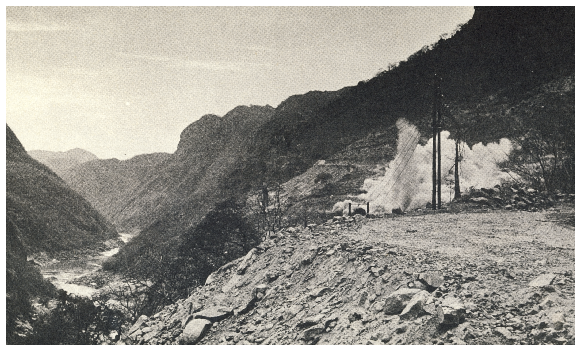
Above: July 1971. Blasting the tunnel – 460 m. long by 16 m. wide – to divert the Zambezi river, while engineers laid the dam’s foundations. Photo: WCC.
◊ 19 July 1971
Le département d'état et Cabora-Bassa. Africasia [Paris], no.45, 19 July 1971, p.23. Click here to view or download a PDF, size 70 kb.
◊ 10 February 1972
Destruction of Cabora Bassa explosives lorry. Radio broadcast from Lourenço Marques on 10 February 1972, reported in the Summary of World Broadcasts [London]. Click here to view or download a PDF, size 38 kb.
◊ 26 February 1972
Cabora Bassa: a reality set in the heart of Mozambique. Economist [London], 26 February 1972. Click here to view or download a PDF, size 345 kb.
◊ March 1972
Cabora at crisis point. African Development [London], March 1972. Click here to view or download a PDF, size 186 kb.
◊ 3 March 1972
L'exploitation des minerais dans la région de Tete-Cabora Bassa. Marchés Tropicaux et Méditerranéens [Paris], 3 March 1972. Click here to view or download a PDF, size 150 kb.
◊ 4 March 1972
Cabora Bassa. Star [Johannesburg], 4 March 1972. The South African parliament is to vote a R2,8 million loan for Cahora Bassa. Click here to view or download a PDF, size 17 kb.
◊ November 1972
Pylon route shifted for security reasons. Anti-Apartheid News [London], November 1972. Click here to view or download a PDF, size 38 kb.
◊ March 1973-30 April 1973
Mozambico: dalla schiavitù alla rivoluzione [Italian: Mozambique from slavery to revolution]. Lunga Marcia [Milan], no.2, March 1973-30 April 1973, p.33-34. The periodical was published by the Comitato Vietnam. Click here to view or download a PDF, size 3.1 Mb.
◊ 15 May 1973
Michael Knipe. Portuguese confident of protecting Zambezi river project from attacks by Frelimo guerrillas: Cabora Bassa dam ahead of schedule. Times [London], 15 May 1973. Click here to view or download a PDF, size 132 kb.
◊ 17 May 1973
Mozambique rebels blow up train. Daily Telegraph [London], 17 May 1973. Click here to view or download a PDF, size 26 kb.
◊ 3 June 1973
The Cabora Bassa stockade. Hindu [Madras], 3 June 1973. Click here to view or download a PDF, size 243 kb.
◊ 22 September 1973
Fascists plan town at Cabora Bassa. Daily News [Dar es Salaam], 22 September 1973. Click here to view or download a PDF, size 35 kb.
◊ 1 December 1973
Cabora, new energy hope for S[outh] Africa. Star Weekly [Johannesburg], 1 December 1973. Click here to view or download a PDF, size 61 kb.
◊ 30 August 1974
Cabora Bassa: no sweat for Escom. Financial Mail [Johannesburg], 30 August 1974. Click here to view or download a PDF, size 97 kb.
◊ 2 September 1974
Cabora Bassa: destruídas duas torres da linha de transporte de energia. Século [Lisbon], 2 September 1974. Click here to view or download a PDF, size 256 kb.
◊ 27 September 1974
Plenty of power, not a drop of glory. Guardian [London], 27 September 1974. Click here to view or download a PDF, size 147 kb.
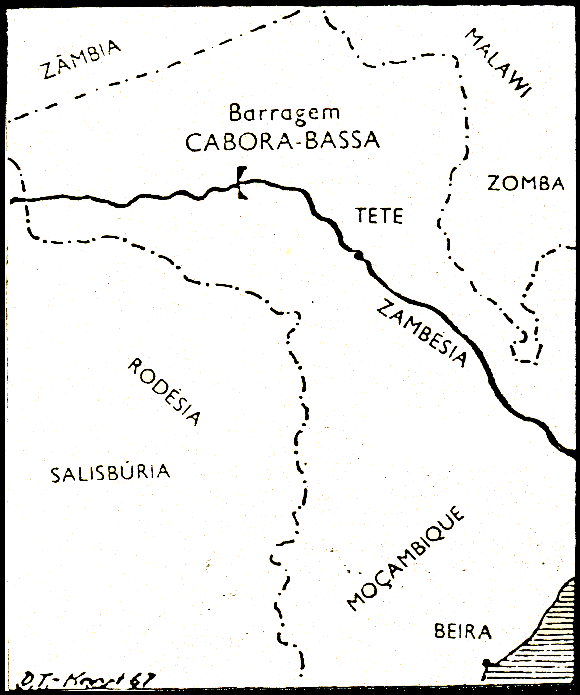
Above: a sketch map published in a Portuguese newspaper, showing the location of the Cahora Bassa dam in Tete province.
◊ 3 December 1974
Cabora Bassa to start electricity supply in August. Agence France Presse [Paris], 3 December 1974. Click here to view or download a PDF, size 33 kb.
◊ 3 December 1974
Defesa de Cabora Bassa confiada à Frelimo em Fevereiro. A Capital [Lisbon], 3 December 1974. Click here to view or download a PDF, size 905 kb.
◊ 4 December 1974
As tropas portuguesas deixarão Cabora Bassa no princípio do ano. Diário de Notícias [Lisbon], 4 December 1974. For an English translation of this story click here, 19 kb. file. Click here to view or download a PDF, size 138 kb.
◊ 6 December 1974
[Cabora Bassa: half of production for S. Africa?]. Século [Lisbon], 6 December 1974. Original unavailable. English translation only. Click here to view or download a PDF, size 18 kb.
◊ 6 December 1974
Le problème des bénéfices tirés de l’exploitation du barrage de Cabora Bassa n’est pas résolu. Marchés Tropicaux et Méditerranéens [Paris], 6 December 1974. Click here to view or download a PDF, size 39 kb.
◊ 31 December 1974
Power: Mozambique. Africa Research Bulletin [Exeter], vol.11 no.11, 31 December 1974. Based on stories from the Star [Johannesburg], 23 November 1974; Daily Telegraph [London], 25 November 1974; and the Times [London], 6 December 1974. Click here to view or download a PDF, size 80 kb.



![Aluka: Struggles for Freedom [subscription required] Struggles for Freedom](imgs/aluka_200.png)



